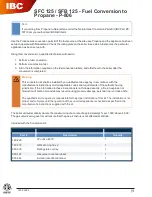
39
NOTE: If the unit powers up with the number of stages selected by dip switches exceeding the number of FCBs, the MCB will detect
this condition and go into a hard lockout.
After changing the dipswitches, the power must be cycled off and back on to accept
any changes.
Example of Dipswitch configuration:
VB model, 1ignition trial, not used, tank / remote probe, no power vent, No LWCO,
no low gas pressure, modulation, not used, not used.
MCB - Three position Dipswitch:
This dipswitch is similar to the MCB dipswitches described above, but with only three switches being used: the number of blower speeds
(switch #3), Hi Gas option (switch #2) and a spare (switch #1). Only the blower speed and Hi Gas options are the required selection,
within the MCB, see Figure 17.
TABLE 14.
Dipswitch Function:
Dipswitch Position
Switch 1: Spare:
Switch 2: Hi Gas pressure switch:
On = Yes
Off = No
Switch 3: Number of Blower Speeds:
On = 1 speed,
Off = 2 speed
Example of Dipswitch configuration:
No High Gas, 1 blower speed..
OPERATING SEQUENCE
1. The EMC modulation controller has four modes of operation:
Initialization, Standby, Running/Modulation, and Service. The
internal MCB micros control these modes through a sequence
of steps (or States) which are further described in the “UIM
Operating Procedures” section.
2. When power is applied to the system, it enters the initialization
mode and the following automatic functions are performed:
• A. O. Smith opening screen is displayed.
• The system goes through a calibration indicated by the
green running LED blinking and then staying on; next the
red service LED and yellow standby LEDs come on, next
the service and runnings LEDs blink ON and OFF.
• Stored values are recalled from memory.
• Configuration dipswitches are read.
• Pending faults are recalled
• Micros on all boards start running (indicated by a flashing
Yellow LED near each micro)
• Input sensors are read
3. After initialization is complete (approximately 10 seconds)
the system turns the green LED off and goes to the standby
mode (yellow “Standby” LED on), unless a previously stored
fault has been recalled, which will send the system into the
service model (red “Service” LED on). In standby mode the
display shows the temperature screen and in fault mode the
current error screen is displayed.
4. The system then compares the temperature read from the
controlling probe (inlet or tank) to the setpoint temperature. If
the temperature is less than the operating setpoint minus the
differential temperature and the thermostat input is closed then
a call for heat is established and the system shifts to the run
mode (green “Running” LED turns on).
5. The heating sequence begins by applying power to the pump.
6. After a few seconds the blower is turned on for 30-second
pre-purge period of combustion chamber.
7. The igniter is turned on.
8. After the igniter has reached a minimum of 2.8 amps, the gas
valve is energized to allow gas flow to burner.
9. After an additional one second, the system checks the status of
the flame through the flame sensor. If the flame is not verified
within 4 seconds, the gas valve is immediately shut off followed
by 15-second inter-purge period, then the system returns to
step 7, if the “Trial for Ignition” dipswitch is set for three (3) tries.
If the dipswitch is set for one (1) trial, the system will declare
an error and boiler will require resetting the control.
10. The boiler will remain running until the set point is satisfied.
Once satisfied, the blower will continue for 15-second post
purge period.
11. Once set point has have been satisfied, the boiler pump will
continue to run for the programmed post-circulate cycle.
12. The control now enters the idle state as displayed by the
“Standby” LED. The control will continue to monitor heat
demand and state of other system devices. Upon a drop of
water temperature below the set parameters, the control will
return to step 5 and repeat the entire operating cycle. Note:
Any fault detection, during standby or running modes, will halt
the heating sequence and shift the system to the service mode
where the detected fault will be displayed.
NOTE: In standby and running modes the system constantly
monitors the signals and the internal operation for faults. Any
detected fault will halt the heating sequence and shift the system
to the service mode, where the detected fault will be displayed.
TEMPERATURE SETPOINTS (SYSTEM CONTROL ALGORITHM)
The boiler has a hysteresis type control, which means that it will
begin heating the water when the temperature sensed by the
control probe (inlet or tank) falls below the operating setpoint minus
the differential setpoint. It will stop heating the water when the
temperature rises to the operating setpoint.
Содержание VF VB 500
Страница 3: ...3 GENERAL SAFETY...
Страница 30: ...30 Wiring Diagram FIGURE 17 CONNECTION DIAGRAM...
Страница 31: ...31...
Страница 32: ...32 FIGURE 18 SCHEMATIC DIAGRAM VB VW 500 750 1000 SCHEMATIC DIAGRAM...
Страница 36: ...36 LIGHTING OPERATION INSTRUCTIONS FOR MODELS VB VW 500 750 AND 1000...
Страница 48: ...48 notes...
Страница 49: ...49 notes...
Страница 50: ...50 notes...














































